Edward Willett's Blog, page 41
August 14, 2013
A Heartbreaking Science Fiction Film About the Uncaring Nature of the Universe
Directed by Edward Willett. Animated by Edward Willett. Sound by Edward Willett. An Edward Willett production.
When Words Collide 2013
Just got home yesterday from a weekend at Calgary attending this year’s edition of When Words Collide, which describes itself (accurately) as “a festival for readers, writers, artists and publishers of commercial and literary fiction, including genre, YA, children’s books, and poetry,” and wanted to post about it while it’s still fresh, in the hopes that you–yes, you–will attend it next year, if you have an interest in writing. Or, for that matter, reading.
This was my second year to attend When Words Collide, which is only in its third year. It took place at the Carriage House Inn, a Calgary hotel which I was pleased to revisit, since it was the location of the very first science fiction I attended in Calgary, ConVersion, back in the mid-1990s (and for a couple of years in a row thereafter). The hotel has been revamped since then, although apparently they need to do a little additional revamping, since one of the two elevators was out of order for the entire weekend–a bit of a problem since readings, book launches and parties were all on the 10th floor. (Yes, you COULD use the stairs, and I did several times to get to our room on the fifth floor and a couple of times all the way to the 10th, but arriving at a reading breathing heavily really only works for romance authors.) The convention space itself, however, was ideal, with several rooms opening off of a kind of lobby where one could mix and mingle between panels. And there was a stellar lineup of Guests of Honor: Patricia Briggs, fantasy and urban fantasy author; Michael Cassutt, a scriptwriter and producer for TV an film, and a science fiction author; David B. Coe/D.B. Jackson, who writes fantasy, mystery and historical fiction; Barbara Fradkin, mystery author; Shirlee Smith Matheson, who writes young adult books and biographies; and Jamis Paulson, editor of Turnstone Press and Ravenstone Press.
The organizers kept me busy this year (which is the way I like it). I was on four panels in total, beginning with, Friday afternoon, “Violence in Literature.” Five of us, myself, S. G. Wong, Dwayne Clayden, Lynda Williams, Axel Howerton, and D.B. Jackson, all agreed that violence in literature is a good thing. (I was moderating and was rather disappointed we didn’t have someone who would argue otherwise.) Of course, digging a little deeper, what we were all really saying is that violence is often a part of exciting, reader-enthralling stories: violence per se does not make a story good, but scenes of violence are often necessary to tell a good story, and in some genres are even expected. Many of the audience questions were directed at Dwayne Clayden, who’s been a paramedic for 30 years, is a former police officer, and writes hard-boiled detective stories and police procedurals, because part of the discussion focused on how realistic the depiction of violence is in stories and what writers get wrong. (He made several interesting points, including noting that there are no rules in a real-life fight and that in the real world fights rarely last more than 30 or 40 seconds simply because they’re exhausting: if someone hasn’t won the fight in that amount of time, the protagonists are pretty much reduced to panting at each other.)
My second panel, “Transhumanism,” was on Saturday afternoon. If you’re not familiar with the concept, allow the program description to explain: “Western society is rapidly moving toward a time when many dreams of the transhumanism movement, such as advanced genetic engineering, prosthetics, organ/neuro-implants, and age retardation/reversal will become reality. The question is how society – including speculative fiction writers – will respond to this evolutionary change in human beings.” Panel members included, besides myself, Matthew Johnson, Nina Munteanu and Ron Friedman. We had an interesting discussion about what these kinds of advances might mean both to individuals and society as a whole. My own novels Marseguro and Terra Insegura deal with genetically modified humans: my take in those books is that there could well be a backlash against the transhumans by the unmodified humans. Of course, you could also write a story in which the advanced humans enslave the ordinary humans; or one in which the advanced humans keep their enhancements to themselves and work quietly behind the scenes to alter society, or even a cop-buddy movie in which a non-modified cop is paired with one with the latest enhancements: the possibilities for story are as limitless as the possibilities may be for the human race going forward.
My third panel, also on Saturday, featured myself, Ronald Hore, Ron Friedman and Peter Halasz, and was entitled “The God Particle.” I confess my heart quailed a little when I first read the program description: “What if we had proof positive, one way or another, of the existence or non-existence of a supreme being? What form would such incontrovertible proof take? What would be the immediate impact of that proof on society, and what would be the long-term consequences?” That’s because I knew it had the potential to devolve into a fruitless argument between atheists and believers (not to mention agnostics, believers from different traditions, etc., etc,.). So I was rather glad to once more be moderator, establishing right up front that the panel was not about our personal beliefs but strictly about the question at hand. Although there were flashes of the kinds of argument I feared (I did have to ask two audience members to stop having a rather loud discussion between themselves while we were trying to listen to a comment from another audience member), I think I kept it on track and in hand (and a couple of people thanked me for it), and it proved to be an enjoyable panel. Toward the end I finally formalized my own take on the question. First of all, there can be no incontrovertible proof because you cannot convince everyone of anything. As for the effects on society, it seems to me that we are already running this experiment. There are plenty of people in the world who believe without question in a supreme being: for them, the proof is already incontrovertible. Conversely, there are plenty of people who believe that no supreme being exists; they are as true to their non-belief as the believers are to their beliefs. And of course there are many gradations in between those two extremes. Want to know how proof of God might alter society? Study the way those who believe live their lives. Want to know how proof of God’s non-existence might alter society? Study the lives of atheists. And then imagine a world filled only with people of either kind…and then write a story about it; because as I kept emphasizing, this question was being asked in the context of a writing conference. (How about a story about the only atheist in a world of absolute belief? Or vice-versa?)
My final panel, first thing on Sunday, was entitled “Stories for the Whole Family.” Moderated by Anna Bortolott, it featured myself, Guest of Honor Shirlee Smith Matheson, and Karen Bass. The discussion was about crossover novels: novels that appeal to both young readers and adults. As E.C. Blake, of course, I’m writing a trilogy, beginning with Masks, I really hope will have just such crossover appeal. The panel in a nutshell? Write a really good story and the readers will find it. Simple, eh?
In addition to the panels, I served as reader for two sessions of Live Action Slush, in which editors listen to a page of fiction, submitted anonymously, read aloud, and put up their hand when they hear something that would make them stop reading if said manuscript had arrived in the slush pile. This is actually more fun (if harder on the authors) if the editors are fairly mean about it. The first Live Action Slush I read for was focused on YA books, and the editors were very nice, generally letting me read all the way to the end of the page–even through a few things I would have put my hand up for if I were on the editor side of the panel. What made that session particularly fun was that among the anonymously entered samples was a page from my 12-year-old daughter, Alice, which (if I do say so myself) was on par with many of the adult-written samples. She created a bit of a stir when she stood up and identified herself as the author. My daughter, the writer. (Sniff.) Fortunately, she wants to be a chemical engineer instead, because, really, I don’t need the competition.
The second session I read for featured fantasy, and here the editors were stricter, with many pieces getting cut off in fairly short order (and again, I would have cut some of them off even sooner than the editors did). As I said, that’s a little tougher on the writers, but at least it allowed us to read every single submission, which we didn’t manage in the YA session.
My other major excitement for the weekend was launching two books. One, Spirit Singer, is a re-release from Edmonton’s Tyche Books of the YA fantasy that won the Regina Book Award at the Saskatchewan Book Awards in 2002. I read from it twice, once at Tyche’s own book launch (which I left early, I admit, to go watch Alice on her very first panel, made up of kids talking about the books they read, what they look for in a book, and how they decide what to read, their every word hung on by a room full of YA writers eager to hear from the horses’ mouths), and once at a multi-book launch by several YA and children’s authors. The new edition is very handsome and I’m very pleased to have the book more widely available again. (Interesting side-note: one of the judges who awarded the book the Regina Book Award in 2002 was Shirlee Smith Matheson, one of the guests of honor! I hadn’t made the connection until she made a point of telling me. Very cool.)
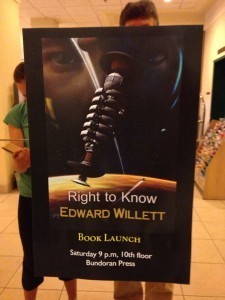 The second launch was for Right to Know, my new science fiction novel published by (or about to be published by; the official release date is still a few days away) Bundoran Press, the fist book acquired by its new owner and editor, Hayden Trenholm. I signed quite a few copies over the course of the weekend, so I know people were buying it. Most exciting of all was the fact that the first time I saw Hayden he asked me to write a sequel, to come out next October. It’s the first time I’ve ever actually made a book deal at a convention! I’m really looking forward to writing it and I’m honored to have been asked.
The second launch was for Right to Know, my new science fiction novel published by (or about to be published by; the official release date is still a few days away) Bundoran Press, the fist book acquired by its new owner and editor, Hayden Trenholm. I signed quite a few copies over the course of the weekend, so I know people were buying it. Most exciting of all was the fact that the first time I saw Hayden he asked me to write a sequel, to come out next October. It’s the first time I’ve ever actually made a book deal at a convention! I’m really looking forward to writing it and I’m honored to have been asked.
Flesh out the weekend with meals with friends, interesting conversations, the always-fun Writers at the Improv session I participated in (in which teams of writers compete to create the most popular sentences in a story created on the fly from words provided by the audience), and a chance for me to sing “Old Man River” (at the Right to Know book launch, at the request of Robert J. Sawyer), and you can see why I had a great time–and why I’m already looking forward to next year’s edition of When Words Collide, which will also be at the Carriage House Inn.
Really, you should go.
July 31, 2013
Kickstarter campaign to bring immersive fantasy roleplaying to mobile devices…and I’m the writer!
Project Snowstorm is an effort by fledgling computer game company Snowfury Studios to do nothing less than revolutionize mobile gaming: to bring to it the kind of immersive fantasy roleplaying we associate with the best PC games, the kind of games that give you that same feeling of having experienced a great adventure that you get in a good fantasy novel.
Of course, to achieve that, you need a good writer and, well…for this project, that’d be me! (That’s “Mr. Loremaster” to you, buddy. :) )
In addition to writing the game itself–backstory, quest lines, dialogue trees, etc.–I’ll be writing at least a 40,000-word novella and hopefully an 80,000-word novel set in the game world, to be given as one of the rewards for backers.
All of this is predicated on achieving a minimum of $500,000 in backing on Kickstarter over the next 29 days, of course.
So please take a look at the campaign, and if it looks like a game you’d like to play, or if you just want to encourage the development of top-notch fantasy roleplaying entertainment (and who doesn’t?) throw in a few bucks. (Or better yet, a lot of bucks. :))
July 30, 2013
Book launch for Right to Know at When Words Collide in Calgary August 10
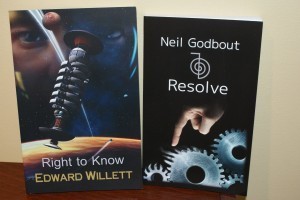 The release of my science fiction novel Right to Know (the first chapter of which you can read here) is drawing near, and in honor of that fact, the publisher, Bundoran Press will be holding a book launch for it at When Words Collide in Calgary on the evening of Saturday, August 10. Also launching: Resolve, the third book in Neil Godbout’s Broken Guardian series.
The release of my science fiction novel Right to Know (the first chapter of which you can read here) is drawing near, and in honor of that fact, the publisher, Bundoran Press will be holding a book launch for it at When Words Collide in Calgary on the evening of Saturday, August 10. Also launching: Resolve, the third book in Neil Godbout’s Broken Guardian series.
And apparently, as you can see from the photo from Bundoran, copies of the book have arrived from the printer. So it’s a real thing!
The cover art, by the way, which I love, is by Dan O’Driscoll.
July 14, 2013
Cover art for Tesseracts Seventeen: Speculating Canada from Coast to Coast
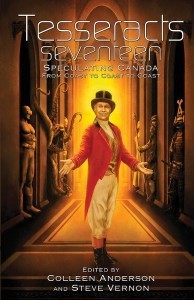 Here’s the gorgeous cover art for Tesseracts Seventeen, the venerable Canadian speculative fiction anthology which this year contains my short story “The Path of Souls,” inspired by Globe Theatre’s Lanterns on the Lake events of a few years ago.
Here’s the gorgeous cover art for Tesseracts Seventeen, the venerable Canadian speculative fiction anthology which this year contains my short story “The Path of Souls,” inspired by Globe Theatre’s Lanterns on the Lake events of a few years ago.
Tesseracts Seventeen, edited by Colleen Anderson and Steve Vernon, has as its subtitle Speculating Canada from Coast to Coast, the theme this year being writers from across the country. There are 29 pieces in all, with me holding down the Saskatchewan spot.
You’ll have to wait for the book to come out to read my story, of course (or any of the others), but by way of a teaser, here’s how it begins:
HELLO, TRAVELLER. How may I help you?
It’s true I am not Andillan. Nor are you, obviously. Not enough fur.
Ah, you’re curious. You are wondering what a human woman is doing on such a strange, remote world.
Are you a journalist, perhaps? An academic? No? Just a traveller?
I do not share my story, as a rule. Others have come, and asked the questions you ask, and always I have turned them away. But tonight… tonight, fortune smiles on you. Tonight, I am in the mood to answer questions. It is, after all, my final opportunity…
Tesseracts Seventeen: Speculating Canada from Coast to Coast is published by EDGE Science Fiction & Fantasy Publishing. I urge you to buy multiple copies upon its release.
July 9, 2013
Ford Green Driving Event…and a week with a C-MAX hybrid
 My Ford-driving adventures continue, because Ford continues to see fit to let me drive media cars and blog about them. Which is very nice. (Any other car companies want to do the same? Ferrari, perhaps? :))
My Ford-driving adventures continue, because Ford continues to see fit to let me drive media cars and blog about them. Which is very nice. (Any other car companies want to do the same? Ferrari, perhaps? :))
Ford held a special event in Regina on June 18 to showcase its “green driving” efforts. A number of media types gathered in the parking lot of the RCMP Heritage Centre to learn about the latest Ford efforts in fuel efficiency and sustainability, take short test drives, and have a very pleasant lunch. Then, just this past week, I had the opportunity to spend a week driving one of the cars highlighted at that event, the C-MAX hybrid.
The event started with a video conference call with Gil Portalatin, Ford’s Chief Program Engineer, Electrified Powetrain Programs and Integration, who pointed out that Ford is the second-largest producer of electrified vehicles in the world, outside of Toyota. Ford makes hybrids (in which the battery that drives the electric side of the powertrain is charged by the internal combustion engine), plug-in hybrids (ditto, but with the added feature that the driver can also choose to drive it as a fully electric vehicle and charge it up as you would an electric) and full-electric vehicles.
Ford’s goal is to is have an option that fits anyone’s lifestyle, “something to suit any customer’s needs.”
A hybrid, of course (Ford offers two, the Fusion Hybrid and the C-MAX Hybrid), can be driven like any other car, with no need to worry about range: less need than with a regular car, in fact, since the hybrid uses the electric motor when it can, making the car highly fuel-efficient, with a range of about 1,200 kilometres on a full tank: its stated fuel efficiency is 4.0L/100 km in the city and 4.1L/100 km on the highway.
 A plug-in hybrid (again, Ford has too: the Fusion Energi and the C-MAX Energi) offers the choice of driving a fully electric vehicle for short trips around town, then switching to gasoline for long trips. It’s stated fuel efficiency is impressive at 1.9 L/100 km city/highway combined.
A plug-in hybrid (again, Ford has too: the Fusion Energi and the C-MAX Energi) offers the choice of driving a fully electric vehicle for short trips around town, then switching to gasoline for long trips. It’s stated fuel efficiency is impressive at 1.9 L/100 km city/highway combined.
The fully electric Ford Focus, meanwhile, has a 160-kilometre range at full charge, and a respectable top speed of 135 kph.
On the regular-engine side, Ford touts its EcoBoost lineup of smaller-displacement turbocharged engines, which, it says, “provides fuel savings of up to 20 percent and CO2 reductions of up to 15 percent compared with conventional engines.”
Ford is aiming to reduce carbon dioxide emissions from its vehicles by 30 percent in the U.S. and Europe and, over the next decade, to reduce weight from 250 to 750 pounds (depending on the type of vehicle), without compromising safety.
At the “Power of Choice” event, one of the other things Ford was highlighting was its sustainable materials strategy, its effort to find ways to use recycled or renewable material. So every Ford built in North America features soybean-based foam in seat cushions, backs and head restraints, which saves about five million pounds of petroleum annually. Yarns are being made into seat fabrics, denim is being recycled into interior padding, nylon carpeting is being recycled into resin for cylinder head covers, etc. Wheat straw, wood chips and corn husks are finding their uses, too, as is coconut fiber. The seat fabric in each electric Focus uses about 22 recycled 22-ounce plastic bottles.
Technology can go a long way toward increasing fuel efficiency, but the person at the wheel has a lot to do with it as well, and the other focus of the Power of Choice event was on green driving tips: i.e., aim for a constant speed, accelerate and brake smoothly, don’t leave the car idling, keep tires properly inflated, minimize the use of climate controls, etc., etc.
So, all that said, what were the cars like? On hand were a C-MAX Hybrid, a C-MAX Energi, and an Escape with EcoBoost.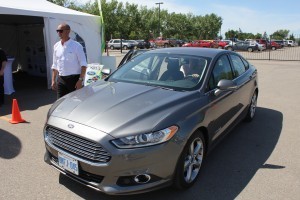
Uniformly, as I’ve found with all the Fords I’ve driven, they were a pleasure to drive. The test drives were short, but you’d be happy to live with any of the vehicles on a day-to-day basis, it seemed to me. Controls are well-designed, interiors are comfortable, even for someone of my size (6’2″), and…well…I’d be happy to own any one of them.
I got a chance to experience the C-MAX Hybrid (that’s the white one in the photos) much better last week, however, when I got to drive one for a week. Never got the chance to try it on the highway, but around town I enjoyed it a lot. And having driven a hybrid once before, this time I wasn’t taken aback the first time I pulled up to a stop sign and it felt like the engine had just died…because, of course, it had, switching to electric.
The last time I drove a hybrid was for a green driving challenge where the whole point was to score the highest fuel-efficiency among several drivers at the end of the challenge period. This time I was just using it as a second car, but I still found that I modified my driving simply because of the hybrid technology. It wasn’t because of the little cartoony screen where green leaves grow the more efficiently you drive: if there’s one thing I’d urge Ford to scrap, it’s that annoying bit of preachiness. It was simply because there’s something satisfying about the smoothly quiet feel of the electric motor. Golf carts are fun to drive for the same reason. I kept trying to keep the gauge that shows if you’re suing the gas engine or the electric motor from flipping over to the gasoline side. Admittedly, I could only do that on quiet streets where nobody would be riding my rear bumper wondering why I was accelerating at the pace of an arthritic snail, but when I could, I did.
 As for the rest of the car: again, it was comfortable, it was a nice size, it had all the nice Ford features I’ve come to enjoy, including a rear-view camera and a hands-free tailgate, and it had the MyFord Touch system with which I continue to have a love-hate relationship. Despite having driven several Fords with this computerized hands-free controller for things like entertainment, climate control and navigation, I still get annoyed at its voice telling me to “Try saying a device name, like…” over and over because I forgot what precise word goes with what precise function or simply because it failed to understand me. But maybe I’m just getting old and curmudgeonly.
As for the rest of the car: again, it was comfortable, it was a nice size, it had all the nice Ford features I’ve come to enjoy, including a rear-view camera and a hands-free tailgate, and it had the MyFord Touch system with which I continue to have a love-hate relationship. Despite having driven several Fords with this computerized hands-free controller for things like entertainment, climate control and navigation, I still get annoyed at its voice telling me to “Try saying a device name, like…” over and over because I forgot what precise word goes with what precise function or simply because it failed to understand me. But maybe I’m just getting old and curmudgeonly.
Nah.
So, bottom line: Ford is, as far as I can tell, working hard to achieve its goal of improved sustainable performance in all of its cars. I’m still not in the market for a new car yet, but when I am, there’s no question Fords will be high on my list of possibilities…and the C-MAX Hybrid or Energi would be high on my list of Fords.
June 24, 2013
Cover art for Right to Know
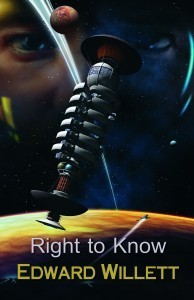 Here’s the gorgeous cover for my upcoming science fiction novel Right to Know, coming out from Bundoran Press in August (we’ll be launching it at When Words Collide in Calgary: launch party planned for Saturday night, August 10!) The artwork is by Dan O’Driscoll–I’m planning to use him for Star Song, the YA novel I serialized on here a while ago, when I finally get around to independently publishing it.
Here’s the gorgeous cover for my upcoming science fiction novel Right to Know, coming out from Bundoran Press in August (we’ll be launching it at When Words Collide in Calgary: launch party planned for Saturday night, August 10!) The artwork is by Dan O’Driscoll–I’m planning to use him for Star Song, the YA novel I serialized on here a while ago, when I finally get around to independently publishing it.
Right to Know is available for pre-order now on Amazon and other sites. Here’s the blurb:
Right to Know by Edward Willett, the Aurora-winning author of over fifty books, is a fast-paced space opera about first contact – with a difference. When Art Stoddard, civilian information officer of the generation ship Mayflower II, is kidnapped by a secret military organization determined to overthrow the power of Captain and crew, he becomes embroiled in a conflict that tests everything he thought he knew. Now, he is forced to choose between preserving social order and restoring the people’s right to know. But what if knowledge is the most dangerous thing of all?
June 12, 2013
I’m the “LoreMaster” for a brand-new computer game company…
…called Snowfury Studios. Check out the website (you’ll find me under “Our Team”), and then check out the video below, the teaser trailer for the first proposed game (Kickstarter willing), Project Snowstorm: Rise of the Eternals, hopefully the first in a trilogy.
I’m having a lot of fun working on this and have great hopes for it going forward. Keep an eye on it and when the Kickstarter kampaign kicks in, kick in! :)
June 11, 2013
My short story will be in Tesseracts 17!
Tesseracts is the long-running anthology of Canadian speculative fiction published for the past few years by Calgary’s Edge Publications. I’ve never sold a short story to it…until now. (This may have something to do with the fact I’ve never submitted to it before. Funny how that works.)
Tesseracts 17: Speculating Canada from Coast to Coast to Coast, edited by Colleen Anderson and Steve Vernon, will include my short story “Path of Souls,” a piece inspired by Globe Theatre‘s “Lanterns on the Lake” event of a few years past.
Below is the official announcement.
***
We are pleased to announce the official Table of Contents for Tesseracts 17: Speculating Canada from Coast to Coast to Coast.
This anthology of speculative Canadian writing will be out this fall from Edge Publications. It was no easy task choosing from the over 450 submissions and we had to turn away many a good tale. In the end, we have a representation of Canada that spans all provinces and territories (with the exception, alas, of Nunavut). The tales themselves reach far into the past and much farther into the future.
TESSERACTS 17: SPECULATING CANADA FROM
COAST TO COAST TO COAST
Introduction: Colleen Anderson
Vermilion Wine: Claude Lalumière
Night Journey: West Coast: Eileen Kernaghan
The Wall: Rhea Rose
2020 Vision: Lisa Smedman
Why Pete?: Timothy Reynolds
Bird Bones: Megan Fennell
Bedtime Story: Rhonda Parrish
Graveyard Shift: Holly Schofield
Path of Souls: Edward Willett
Sin A Squay: David Jón Fuller
Hereinafter Referred to as the Ghost: Mark Leslie
Anywhere: Alyxandra Harvey
Secret Recipes: Costi Gurgu
Star Severer: Ben Godby
The Lighthouse Keeper’s Wife: Dave Beynon
Graffiti Borealis: Lisa Poh
My Child Has Winter in His Bones: Dominik Parisien
Team Leader 2040: Catherine Austen
Sand Hill: Elise Moser
The Ripping: Vincent Grant Perkins
Unwilling to Turn Around: J.J. Steinfield
Pique Assiette: Catherine MacLeod
Leaving Cape Roseway: John Bell
Everybody Wins: Rachel Cooper
In the Bubble: William Meikle
Hermione and Me: Dwain Campbell
Blizzard Warning: Jason Barrett
M.E.L.: Dianne Homan
The Calligrapher’s Daughter: Patricia Robertson
Afterword: Editing Anthologies Made Easy: Steve Vernon





